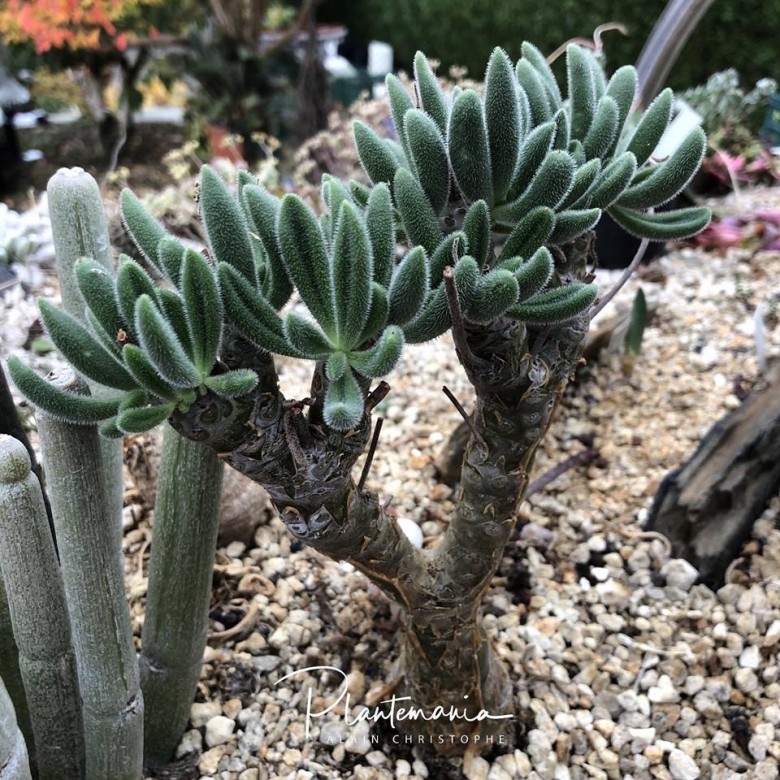Accepted Scientific Name: Tylecodon leucothrix (C.A.Sm.) Toelken
Bothalia 12: 379 1978.

Adromischus leucothrix (Tylecodon leucothrix) Photo by: © Plantemania
Origin and Habitat: Eastern Cape, Western Cape (Ladismith to Vanwyksdorp in the Little Karoo), South Africa.
Habitat and Ecology: Succulent Karoo. Tylecodon leucothrixSN|35479]]SN|35479]] grows in shaded places, sometimes in full sun, usually on south-facing Swartberg foothills and rocky hillsides and often associated with rock outcrops in well-drained, sandy soil. This habitat is rich in succulents, cremnophytes and geophytes, of which some are rare or localized endemic species (e.g. Drosanthemum sp., Glottiphyllum linguiformeSN|31204]]SN|31204]], Haworthia emelyaeSN|13363]]SN|13363]], Pelargonium ochroleucum, Albuca thermarum, Bulbine ramosa, Cotyledon tomentosaSN|27065]]SN|27065]], Crassula badspoortense, Tromotriche choanantha, Gasteria brachyphyllaSN|17303]]SN|17303]] var. bayeri, Hoodia piliferaSN|18887]]SN|18887]] etc.). Portulacaria afraSN|18165]]SN|18165]] may also be present. Blooming season summer (November to February). T. leucothrix is an habitat specialist known from five subpopulations. This plant is rare, although its population is considered to be stable early in the twenty first century and therefore not threatened and not threatened.
Synonyms:
See all synonyms of Tylecodon leucothrix
back
Accepted name in llifle Database:Tylecodon leucothrix (C.A.Sm.) ToelkenBothalia 12: 379 1978.Synonymy: 4
back
Common Names include:
AFRIKAANS (Afrikaans): Doubossie
Description: Tylecodon leucothrixSN|35479]]SN|35479]], sometimes called bunny ears and in Afrikaans commonly known as doubossie (little dew bush), probably because of the way the dew collects on the leaf hairs, is a succulent shrublet with peeling stems to 20(-30) cm tall from an underground tuber (caudex). The leaves are thickly succulent and covered in dense white hairs and generally dry and drop off in summer. The flowers appearing in summer are tubular, white or pinkish.
Derivation of specific name: This member of the Crassulaceae family was given this name by Hellmut R. Toelken in 1978. The specific name leucothrix comes from the Greek words 'leukos', white, glossy; and 'thrix, trichos', hair; for the white hairs on the leaves.
Tuberous rootstock (caudex): The caudex is thick, often branched and variably bulging caudex and can grow to six centimetres. Bark rough and peeling, whitish, grey or dark green
Aerial stems: One to several erect or decumbent smooth stems 4-15(-20) cm long, with pale flaking bark.
Leaves: Dry at flowering, abscising, oblanceolate to linear yellowish green to green, often turning dark seasonally, variable in length (15-40 mm long), and tapering to pointed tips, crowded at the stem tips. Mature leaves are flattened shallowly channelled on their upper surfaces with a deep median groove, all surfaces with dense white hairs.
Inflorescence: A narrow lax panicle or a cyme, glandular-tomentose, few-flowered, the peduncle is 10-20 cm long,erect stalk and emerges from the upper caudex next to the leaves.
Flower. Corolla tube yellowish-green to pale yellow. Lobes pinkish-white.
Bibliography: Major references and further lectures
1) Doreen Court, “Succulent Flora of Southern Africa”, CRC Press, 1 June 2000
2) Goldblatt, P. and Manning, J.C. 2000. "Cape Plants: A conspectus of the Cape Flora of South Africa". Strelitzia 9. National Botanical Institute, Cape Town.
3) Raimondo, D., von Staden, L., Foden, W., Victor, J.E., Helme, N.A., Turner, R.C., Kamundi, D.A. and Manyama, P.A. 2009. "Red List of South African Plants". Strelitzia 25. South African National Biodiversity Institute, Pretoria.
4) Bruyns, P.V. & Raimondo, D. 2006. Tylecodon leucothrix (C.A.Sm.) Toelken. National Assessment: Red List of South African Plants version 2017.1. Accessed on 2018/11/04
5) Urs Eggli, Leonard E. Newton “Etymological Dictionary of Succulent Plant Names” Springer Science & Business Media, 11 March 2004
6) Vlok, J.H.J., Cowling, R.M. & Wolf, T., 2005. “A vegetation map for the Little Karoo.” Unpublished maps and report for a SKEP project supported by CEPF grant no 1064410304. web: https://www.gouritz.com/file/repository/Klein_Karoo_Vegetation_Report_Vlok_et_al_2005.pdf
7) R.R. Klopper, P.C. Zietsman, “Flowering Plants of Africa” Volume 64, Pretoria 2015
8) CAPENATURE. 2018. “Anysberg Nature Reserve & World Heritage Site. Protected Area Management Plan 2018-2028”. Unpublished Internal Report, Cape Town, South Africa. Web: http://www.capenature.co.za/wp-content/uploads/2018/04/Download-File-2-1.pdf
9) EJ Van Jaarsveld, "CHAPTER 12 SPECIES TREATMENT (Enumeration of the 220 obligate or near-obligate cremnophilous succulent and bulbous taxa)" web: https://repository.up.ac.za/bitstream/handle/2263/25107/04chapter12A.pdf?sequence=5
10) Ivan Latti, “Tylecodon leucothrix”, Operation Wildflower, web: https://www.operationwildflower.org.za/index.php/albums/genera-m-z/tylecodon/tylecodon-leucothrix-thabo-2-6203










